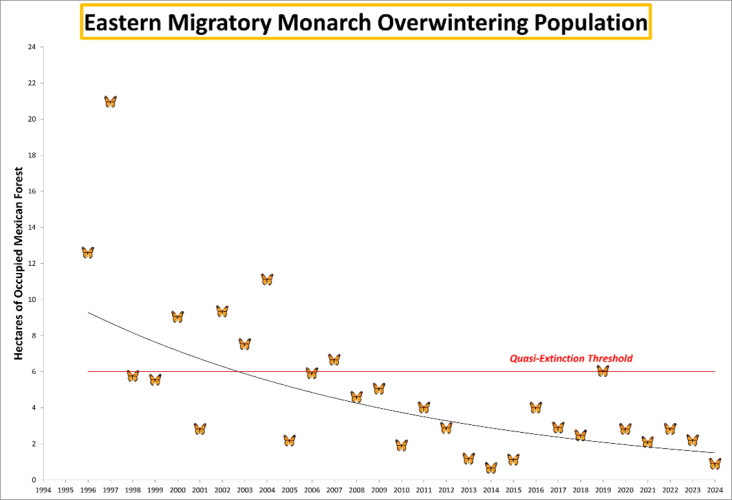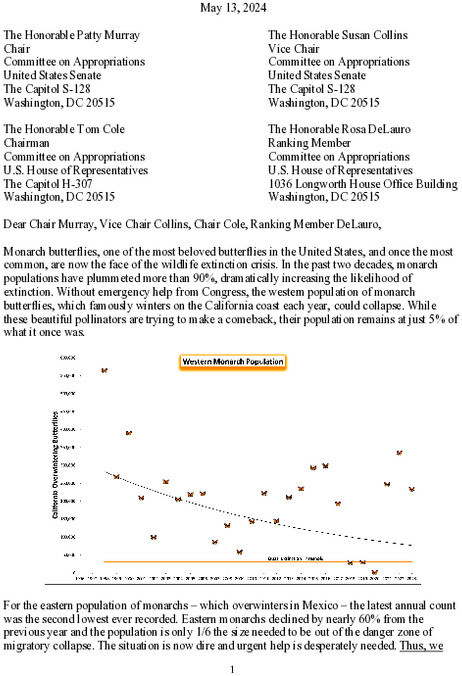From the Open-Publishing Calendar
From the Open-Publishing Newswire
Indybay Feature
Congress Urged to Spend $100 Million to Save Monarch Butterflies
Population Declines 60% as Fish and Wildlife Service Weighs Protections
WASHINGTON, May 13, 2024 — The Center for Biological Diversity, along with over 20 other conservation organizations, called on Congress today to provide more than $100 million per year for the conservation of monarch butterflies to help stem their rapid population decline and prevent extinction.
The latest annual count for the eastern monarch butterfly population was the second-lowest ever recorded. The population declined by nearly 60% from the previous year and is only 1/6 of the size needed to be out of the danger zone of migratory collapse. The western population of monarchs, which famously winters on the California coast each year, remains at just 5% of what it once was.
“More than America’s most beloved butterfly, the monarch is a symbol of wonder, transformation and resilience,” said Stephanie Kurose, deputy director of government affairs at the Center for Biological Diversity. “This may be Congress’ last chance to save monarchs before they become the face of the extinction crisis.”
Monarch butterflies have been moving towards extinction because of landscape-scale threats from pesticides, development and habitat loss in the United States. The loss of overwintering habitat in Mexico is also an existential threat to the monarchs’ future. The oyamel fir stands where the eastern population of monarchs roost are threatened by illegal logging, land conversion for farming, and climate change.
One of today’s letters urges Congress to spend $100 million per year to restore 1 million acres of milkweed and pollinator habitat in the U.S. A second letter calls on Congress to increase funding for the U.S. Forest Service’s International Program to ramp up its efforts in Mexico to combat illegal logging and provide additional capacity for local communities to sustainably manage the monarchs’ overwintering habitat.
“The status quo of paltry funding and half-baked policies doesn’t work,” said Kurose. “If we let monarchs go extinct when we could have saved them, that’s a moral failure on our part.”
Monarch butterflies are currently on the candidate waiting list for Endangered Species Act protection. The U.S. Fish and Wildlife Service has said it would make a final listing determination by December 2024.
Image: The eastern monarch butterfly population in 2024 was only 1/6 of the size needed to be out of the danger zone of migratory collapse.
The Center for Biological Diversity is a national, nonprofit conservation organization with more than 1.7 million members and online activists dedicated to the protection of endangered species and wild places.
https://biologicaldiversity.org/w/news/press-releases/congress-urged-to-spend-100-million-to-save-monarch-butterflies-2024-05-13/
The latest annual count for the eastern monarch butterfly population was the second-lowest ever recorded. The population declined by nearly 60% from the previous year and is only 1/6 of the size needed to be out of the danger zone of migratory collapse. The western population of monarchs, which famously winters on the California coast each year, remains at just 5% of what it once was.
“More than America’s most beloved butterfly, the monarch is a symbol of wonder, transformation and resilience,” said Stephanie Kurose, deputy director of government affairs at the Center for Biological Diversity. “This may be Congress’ last chance to save monarchs before they become the face of the extinction crisis.”
Monarch butterflies have been moving towards extinction because of landscape-scale threats from pesticides, development and habitat loss in the United States. The loss of overwintering habitat in Mexico is also an existential threat to the monarchs’ future. The oyamel fir stands where the eastern population of monarchs roost are threatened by illegal logging, land conversion for farming, and climate change.
One of today’s letters urges Congress to spend $100 million per year to restore 1 million acres of milkweed and pollinator habitat in the U.S. A second letter calls on Congress to increase funding for the U.S. Forest Service’s International Program to ramp up its efforts in Mexico to combat illegal logging and provide additional capacity for local communities to sustainably manage the monarchs’ overwintering habitat.
“The status quo of paltry funding and half-baked policies doesn’t work,” said Kurose. “If we let monarchs go extinct when we could have saved them, that’s a moral failure on our part.”
Monarch butterflies are currently on the candidate waiting list for Endangered Species Act protection. The U.S. Fish and Wildlife Service has said it would make a final listing determination by December 2024.
Image: The eastern monarch butterfly population in 2024 was only 1/6 of the size needed to be out of the danger zone of migratory collapse.
The Center for Biological Diversity is a national, nonprofit conservation organization with more than 1.7 million members and online activists dedicated to the protection of endangered species and wild places.
https://biologicaldiversity.org/w/news/press-releases/congress-urged-to-spend-100-million-to-save-monarch-butterflies-2024-05-13/
For more information:
https://biologicaldiversity.org/
Add Your Comments
We are 100% volunteer and depend on your participation to sustain our efforts!
Get Involved
If you'd like to help with maintaining or developing the website, contact us.
Publish
Publish your stories and upcoming events on Indybay.
Topics
More
Search Indybay's Archives
Advanced Search
►
▼
IMC Network





